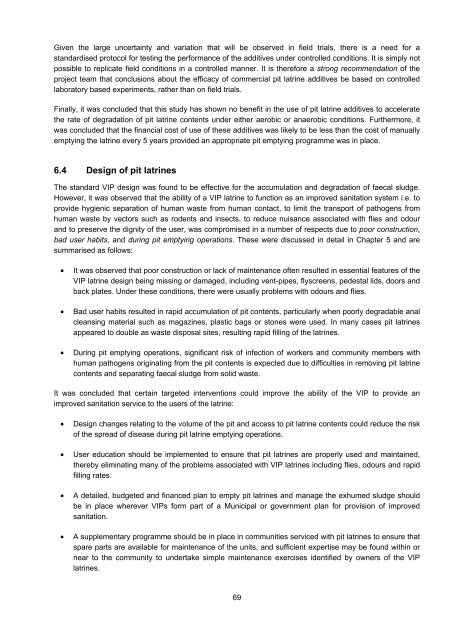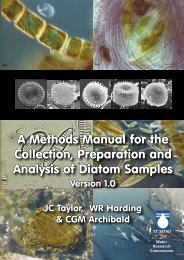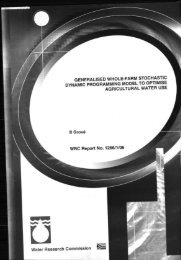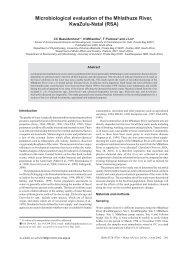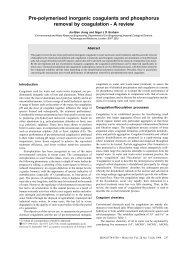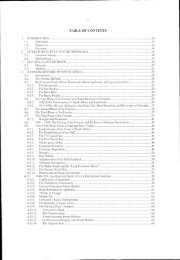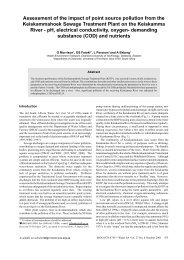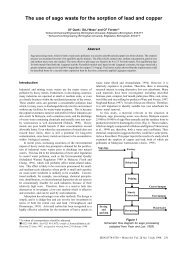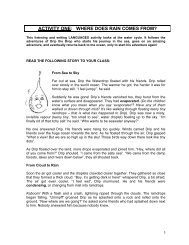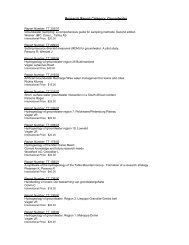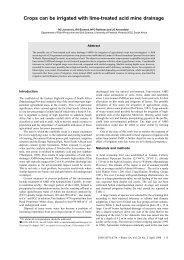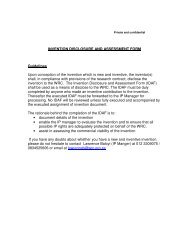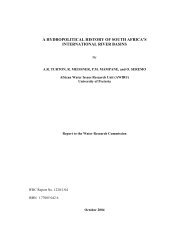and the Efficacy of Pit Latrine Additives - Water Research Commission
and the Efficacy of Pit Latrine Additives - Water Research Commission
and the Efficacy of Pit Latrine Additives - Water Research Commission
- No tags were found...
Create successful ePaper yourself
Turn your PDF publications into a flip-book with our unique Google optimized e-Paper software.
Given <strong>the</strong> large uncertainty <strong>and</strong> variation that will be observed in field trials, <strong>the</strong>re is a need for a<br />
st<strong>and</strong>ardised protocol for testing <strong>the</strong> performance <strong>of</strong> <strong>the</strong> additives under controlled conditions. It is simply not<br />
possible to replicate field conditions in a controlled manner. It is <strong>the</strong>refore a strong recommendation <strong>of</strong> <strong>the</strong><br />
project team that conclusions about <strong>the</strong> efficacy <strong>of</strong> commercial pit latrine additives be based on controlled<br />
laboratory based experiments, ra<strong>the</strong>r than on field trials.<br />
Finally, it was concluded that this study has shown no benefit in <strong>the</strong> use <strong>of</strong> pit latrine additives to accelerate<br />
<strong>the</strong> rate <strong>of</strong> degradation <strong>of</strong> pit latrine contents under ei<strong>the</strong>r aerobic or anaerobic conditions. Fur<strong>the</strong>rmore, it<br />
was concluded that <strong>the</strong> financial cost <strong>of</strong> use <strong>of</strong> <strong>the</strong>se additives was likely to be less than <strong>the</strong> cost <strong>of</strong> manually<br />
emptying <strong>the</strong> latrine every 5 years provided an appropriate pit emptying programme was in place.<br />
6.4 Design <strong>of</strong> pit latrines<br />
The st<strong>and</strong>ard VIP design was found to be effective for <strong>the</strong> accumulation <strong>and</strong> degradation <strong>of</strong> faecal sludge.<br />
However, it was observed that <strong>the</strong> ability <strong>of</strong> a VIP latrine to function as an improved sanitation system i.e. to<br />
provide hygienic separation <strong>of</strong> human waste from human contact, to limit <strong>the</strong> transport <strong>of</strong> pathogens from<br />
human waste by vectors such as rodents <strong>and</strong> insects, to reduce nuisance associated with flies <strong>and</strong> odour<br />
<strong>and</strong> to preserve <strong>the</strong> dignity <strong>of</strong> <strong>the</strong> user, was compromised in a number <strong>of</strong> respects due to poor construction,<br />
bad user habits, <strong>and</strong> during pit emptying operations. These were discussed in detail in Chapter 5 <strong>and</strong> are<br />
summarised as follows:<br />
<br />
<br />
<br />
It was observed that poor construction or lack <strong>of</strong> maintenance <strong>of</strong>ten resulted in essential features <strong>of</strong> <strong>the</strong><br />
VIP latrine design being missing or damaged, including vent-pipes, flyscreens, pedestal lids, doors <strong>and</strong><br />
back plates. Under <strong>the</strong>se conditions, <strong>the</strong>re were usually problems with odours <strong>and</strong> flies.<br />
Bad user habits resulted in rapid accumulation <strong>of</strong> pit contents, particularly when poorly degradable anal<br />
cleansing material such as magazines, plastic bags or stones were used. In many cases pit latrines<br />
appeared to double as waste disposal sites, resulting rapid filling <strong>of</strong> <strong>the</strong> latrines.<br />
During pit emptying operations, significant risk <strong>of</strong> infection <strong>of</strong> workers <strong>and</strong> community members with<br />
human pathogens originating from <strong>the</strong> pit contents is expected due to difficulties in removing pit latrine<br />
contents <strong>and</strong> separating faecal sludge from solid waste.<br />
It was concluded that certain targeted interventions could improve <strong>the</strong> ability <strong>of</strong> <strong>the</strong> VIP to provide an<br />
improved sanitation service to <strong>the</strong> users <strong>of</strong> <strong>the</strong> latrine:<br />
<br />
<br />
<br />
<br />
Design changes relating to <strong>the</strong> volume <strong>of</strong> <strong>the</strong> pit <strong>and</strong> access to pit latrine contents could reduce <strong>the</strong> risk<br />
<strong>of</strong> <strong>the</strong> spread <strong>of</strong> disease during pit latrine emptying operations.<br />
User education should be implemented to ensure that pit latrines are properly used <strong>and</strong> maintained,<br />
<strong>the</strong>reby eliminating many <strong>of</strong> <strong>the</strong> problems associated with VIP latrines including flies, odours <strong>and</strong> rapid<br />
filling rates.<br />
A detailed, budgeted <strong>and</strong> financed plan to empty pit latrines <strong>and</strong> manage <strong>the</strong> exhumed sludge should<br />
be in place wherever VIPs form part <strong>of</strong> a Municipal or government plan for provision <strong>of</strong> improved<br />
sanitation.<br />
A supplementary programme should be in place in communities serviced with pit latrines to ensure that<br />
spare parts are available for maintenance <strong>of</strong> <strong>the</strong> units, <strong>and</strong> sufficient expertise may be found within or<br />
near to <strong>the</strong> community to undertake simple maintenance exercises identified by owners <strong>of</strong> <strong>the</strong> VIP<br />
latrines.<br />
69


